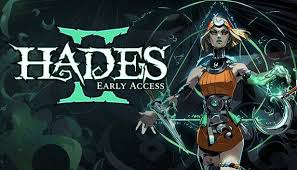
On December 6, 2018, Hades was released. The game was a roguelike where you play as Zagreus, the son of the titular god of the dead, as he tries to escape the underworld and find his long lost mother. A roguelike is a game where you traverse through levels getting upgrades, and you lose all of them upon death. The game’s fun gameplay, amazing art and sound design, loveable characters, and endless dialogue options, won it the prestigious title of 2018’s game of the year. Now, six years later, the long awaited sequel finally enters early access, once again allowing players to jump into the world of the “godlike roguelike.”
Hades ll stars the daughter of Hades, Melinoe; the younger sister of the first game’s protagonist Zagreus — however, the siblings are opposites in almost every way. While Zagreus is a funny, charismatic and laid-back individual, Melinoe has a more serious, diligent and respectful personality. This reflects in their dialogue and relationships with the other characters of the games. They also play extremely differently despite having the same core mechanics, being the attack, special, dash and cast. Zag is the god of teenagers, due to his game being centered on a prolonged and violent conflict with his dad, culminating in repeated brutal battles to the death between the two. This is reflected in how he plays more like a fighter, being extremely dash happy and unleashing an unrelenting torrent of consistent damage at close range. Mel on the other hand, is a member of shadow wizard money gang, and she loves casting spells. Understandably, she plays like an assassin and a witch who fights more patiently and methodically, waiting for her chance to strike before dealing lots of damage in a short window. While Zag can dash to his heart’s content, Mel cannot dash as frequently, which is balanced out by her ability to sprint, which can help her avoid longer attack strings. As a witch, she also has magic which she can channel into her moves to cast powerful omega versions with enhanced effects.
The protagonist isn’t the only thing that’s different about the sequel — so too is the objective. In the first game, the goal was to break out of the underworld and find a family member. In the second, the goal is to break into the underworld and kill a family member. Chronos, the Titan of time, has returned and taken Hades, his family and his associates prisoner. Melinoe’s goal is to kill Chronos and rescue her family, but, as the game frequently reminds you: he is time itself, and time cannot be stopped. Chronos is unique among the cast, possessing a design that looks reminiscent of an egyptian deity, and the ability to control time. Hmm, Egypt and the ability to control time… is that a Jojo reference? Either way, his time control gives him the unique ability to make the player’s mother mad, because if you try to pause the fight, he’ll laugh in your face and resume it, even if you’ve been called for dinner. This, coupled with high damage, high health, and a large variety of moves, makes him a grueling fight. Even if you do manage to defeat him, there is no satisfactory ending because the game is still in early access and thus, unfinished.
The sequel’s progression system is also extremely different from the original. Instead of using a resource called darkness to accumulate upgrades, you use a resource called ashes to unlock arcana cards. These cards each provide some sort of ability, and cost grasp to have active. Because of this, you have to choose what upgrades you want to be active carefully for each run. You can also increase your grasp, and thus the number of cards you can have active, but it is still a careful consideration. Equally important as the upgrades from your character are the upgrades from others. In both games, the way you become stronger during a run is through boons, Which are upgrades to your character’s abilities granted by the Olympian gods — however, the array of gods available to Zagreus is not the same one available to Melinoe. Zagreus could receive boons from Zeus, Poseidon, Athena, Aphrodite, Ares, Dionysus, Artemis, Hermes and Demeter. Melinoe can still receive boons from Zeus, Poseidon, Aphrodite, Hermes and Demeter, but she can also receive them from other gods: Apollo, god of light, Hephaestus, god of smiths, Hestia, goddess of the hearth, Hera, queen of the gods and Selene, goddess of the moon. There are additional gods who function more like encounters than rewards, but they too can give you boons once you finish the encounter. Gods are not the only ones who can assist Melinoe on her quest to slay Chronos however: Arachne, Narcissus, Echo, and more can provide valuable benefits to Melinoe on her way down.
Chronos’ return did not end in an attack on the House of Hades. After taking control of the underworld, he launched an assault on Mount Olympus. Melinoe is made aware of the severity of the issue by Hermes, and that leads to one of the biggest differences between the original and the sequel — the ability to go to the surface. Not only can you attempt to descend into the underworld and kill Chronos, but you can attempt to ascend to the surface and defend Olympus from Chronos’s army. This option was a completely unexpected but welcome addition to the sequel, and the near limitless replayability of the first game was more than doubled by it.
Hades ll is more of what made the first game great. If you liked Hades, you will like Hades ll, period. Everything good about the first game is preserved, and many aspects are improved. I am so excited to see where they take this game from here. I’m hoping for multiplayer with Mel and Zag, but we’ll have to see. This game, even in early access, is the triumphant return of the king of roguelikes, and it’s only going to get better from here.
“Hades ll: Early Access:” ★★★★★









